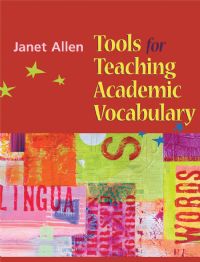A Vocabulary Guide for Non-ELA Teachers
Tools for Teaching Academic Vocabulary
By Janet Allen
(Stenhouse Publishers, 2014 – Learn more)

Why did I not know about this book sooner??? My students surely would have benefitted from all the great ideas in it. Cogent and concise, this resource should be on every teacher’s desk! Given the current focus on reading and writing across the curriculum, the book is especially useful for non-English Language Arts teachers, who may not be as familiar with strategies for teaching literacy skills.
 A flipchart filled with strategies
A flipchart filled with strategies
Tools for Teaching Academic Vocabulary is produced as a small flipchart, with a spiral binding at the top. This makes it easy to photocopy the many student activities in the appendix, which the publisher grants teachers permission to reproduce for use in their classrooms.
The format of the book is consistent throughout and very easy to follow. It is divided into two main sections, one that explains the strategies and a second that includes the graphic organizers needed to implement the strategies.
The first part of Tools for Teaching Academic Vocabulary, which comprises 26 pages—the book is not paginated but I counted them—starts off by explaining the purpose of the book, what a good program of vocabulary instruction should look like, what the various types of vocabulary used in academic contexts are, and the importance of providing students with a variety of language learning experiences.
Word tiers clarified
There is a great “Reference Chart for Vocabulary Types” in this section, which presents four types of words, describes them, places them into the Tier 1, 2, and 3 framework, and discusses their implications for classroom instruction. Anyone who has ever been unsure of the difference between Tier 2 and Tier 3 words will find this chart handy.
Most of the remaining pages in the explanatory section follow the standard format to describe a strategy or activity for learning vocabulary, with subsections that ask these questions:
a) what is the strategy or activity being discussed (i.e., an explanation of it);
b) how can it help in the classroom (i.e., what are the steps for implementing it in classrooms, with examples from actual classes included); and
c) when and why is using it helpful (i.e., the rationale for using the strategy or doing the activity).
Nineteen strategies and activities are presented. Each strategy is described on just one page, long enough to provide helpful background information but not long enough to bore readers with too much theory. A few other pages discuss vocabulary learning in general. All of these subsections open with a quotation relevant to teaching vocabulary, which is a nice, thought-provoking touch.
Practice-oriented organization
Tools for Teaching Academic Vocabulary is very practice-oriented and the numbers at the top of the pages in the explanatory section refer to the pages in the appendix where the corresponding graphic organizers can be found; for some strategies, more than one organizer is offered.
The Appendix takes up 51 pages, all of which are graphic organizers. In the Appendix three pages are intended to be used by teachers for planning purposes, 29 are blank organizers that can be distributed to students, and the remaining 19 are copies of the blank organizers that have been filled in by Allen with examples.
Finally internal and external context clues are clear
I always found it difficult to teach my students how to use context clues, but implementing the strategies in the ways presented in Tools for Teaching Academic Vocabulary seems like it would be very effective. Allen differentiates between using “internal context clues” and “external context clues” and offers five different organizers to address the strategy of using context clues to determine meaning.
So, although many of the strategies were familiar to me, the designs of their graphic organizers were different. In addition, there were some organizers that were completely new to me, such as “3-2-1 Note Taking,” “If the Dictionary Could Talk,” and “Using the Right Word.” A huge variety of vocabulary-learning tasks can be accomplished with these organizers, and I dare any student to become bored learning vocabulary if they use even just half of them!
I do have a couple minor caveats: I’m not sure why “Graphically Organized Learning” is listed as a separate strategy since it seems to me that all the strategies included in this book involve graphic organizers of one sort or another. Regardless, the three organizers in this part seem just as useful as all the others.
My other caveat is that it would have been helpful to include a blank organizer for the “Using the Just-Right Word” strategy. While the organizer is not hard to recreate on one’s own, it seems like it was a lapse not to include it and save teachers time since the book is so thorough and comprehensive in all other respects.
An essential resource for all teachers
Allen writes, “Fortunately, now we have both research and descriptions of classroom practices that highlight effective ways to teach individual words. Unfortunately, knowing which words to teach and how to teach those words is still a complex process.” However, Tools for Teaching Academic Vocabulary goes a long way towards solving this problem. All teachers, no matter what subject they teach, will find this book an essential resource.
Susan Schwartz was an EFL teacher and teacher trainer at universities in China and Indonesia and taught ESL at language schools in the U.S. before spending sixteen years at Marsh Grammar School in Methuen, Massachusetts. There, she most enjoyed teaching Social Studies to ELL middle schoolers, which included a significant amount of vocabulary instruction. Susan traveled to India on a Fulbright-Hays Seminars Abroad program in 2007 and received an ING Unsung Heroes Award in 2010.
Editor’s note: Find an excerpt on word-rich instruction from Janet Allen’s book here at MiddleWeb. More excerpts are available at the publisher’s webpage. And see another review of Tools for Teaching Academic Vocabulary here.































